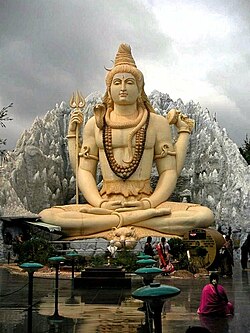Yoga
Yoga is an old discipline from India. It is both spiritual and physical. Yoga uses breathing techniques, exercise and meditation. It helps to improve health and happiness. Yoga is the Sanskrit word for union. Patanjali was a pioneer of classical yoga. He defined yoga as "the cessation of the modification of the mind" (stopping changing the mind).
A person doing yoga will move from one posture (called asana) to another, but there are also other aspects which are important in yoga, such as breath-work, mantras, mudras (postures of the hands and fingers), meditation and much more (for more information, check out the Yoga Sutras). For example, the "sun-salutation" contains 12 poses of asanas, one after the other, and is said to help balance body and soul. There is a specific mantra for each asana. The "sun-salutation" is popularly known as "Suryanamaskar".
History
Yoga was introduced by Indian Ascetic. Ascetic practices (tapas) are referenced in the Brāhmaṇas (900 to 500 BC), early commentaries on the Vedas.[1] Several seals discovered at Indus Valley Civilization (~3300–1700 B.C.) sites in Pakistan depict figures in positions resembling a common yoga or meditation pose. The pose shows "a form of ritual discipline, suggesting a precursor of yoga", according to archaeologist Gregory Possehl.[2] Scholars think there must be some type of connection between the Indus Valley seals and later yoga and meditation practices, though there is no conclusive evidence.
Important yoga words(ashtang yoga)
- Yama: Positive Rules of meditations
- Niyama: Prohibitory Rules of meditations
- Asanas: Physical postures and movements
- Pranayama: Breathing techniques
- Pratyahara: Controlling the mind
- Dharana: Gazing inward
- Dhyana: Meditation with object
- Samadhi: Meditation without object
Types of yoga
- Classification based on mind and body.
- Rajayoga: Raja yoga focuses on meditation and contemplation in order to fully realize the self.
- Hathayoga: Hatha yoga is the practice of yoga postures, or asana, using the body as a vehicle for self-transformation.
- Classification based on way of spiritual life.
- Gyanyoga: It is a way of knowledge.
- Karmayoga: It is a way of work.
- Bhaktiyoga: It is a way of worship.
- Classification based on a way of other things.
- Swaryoga: Emphasizes the most on breathing.
- Kriyayoga: Emphasizes the most on blending Karmayoga (Tapa), Gyanyoga (Swadhyay) and Bhaktiyoga (Ishwar Pranidhan).
Some popular Yogasanas
A yogasana is a pose in which a person can sit. The intention of yogasana is to exercise the body and make it free of pains and problems.
Yogi is a person who has mastered yoga or has achieved great success in yoga. Yogasanas are also called Asana or Asanas (plural). A Yogi can sit in any asana for a given time.
- Pawanmuktasana
This yogasana helps to release gas in the stomach.
- Ushtrasana
References
- ↑ Flood, Gavin D. 1996. An introduction to Hinduism. Cambridge University Press, p94.
- ↑ Possehl, Gregory 2003. The Indus Civilization: a contemporary perspective. AltaMira Press, 144/5. ISBN 978-0-7591-0172-2
- ↑ Around the Indus in 90 Slides by Jonathan Mark Kenoyer
- ↑ Werner, Karel 1998. Yoga and Indian philosophy. Motilal Banarsidass Publ. ISBN 81-208-1609-9 [1]
- ↑ "Ushtrasana". Yoga Point. Yoga Vidya Gurukul. Retrieved 23 July 2016.
Other websites
| Wikimedia Commons has media related to Lua error in Module:Commons_link at line 62: attempt to index field 'wikibase' (a nil value).. |


